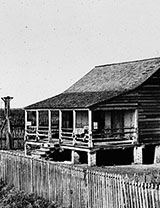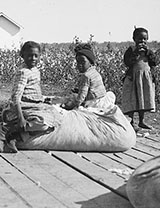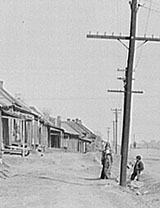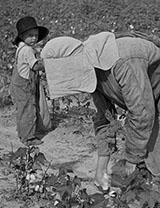Index of Photo Galleries
| CLOSE WINDOW |

|
The world of the Yoknapatawpha fictions has its origins both in William Faulkner's imagination and in reality - in particular, the landscapes (physical, social, ideological, meteorological, and so on) of Mississippi between the early 19th and the mid-20th centuries. 21st century readers have essentially the same texts as readers in 1929, when the first Yoknapatawpha fiction was published, but are likely to have an increasingly attenuated sense of what the real world Faulkner lived in and wrote about was like. The past, Faulkner is famous for saying, is never dead, but how to recover it and see it clearly is both a major thematic concern of his work and a challenge to our modern presumptions. The 225 photographs that are available here are an attempt to provide a set of windows into that earlier world. As windows, however, they are by no means transparent. Even photographs are colored by the preconceptions and intentions of the human agents behind the cameras. The four images below, part of the gallery of photographs from the Library of Congress collections, all re-present the social landscape of Mississippi. The first two were taken between 1880 and 1897 by William Henry Jackson, one of the owners of the Detroit Publishing Company, the second two in the late 1930s by Arthur Rothstein and Walker Evans, two photographers who worked for the Farm Security Administration created by Franklin Roosevelt's administration. In the agricultural world of the Deep South (and Faulkner's fiction), where tenantry replaced slavery but continued to keep landless farm workers in peonage and where mules and plows remained in use long after most of the rest of the country had been using tractors, the decades that separate the two pairs of images matter less than the invisible rhetorical agendas that framed the photographs. The Detroit Publishing Company was famous for its thousands of postcards depicting the picturesque features of the American landscape; its "cotton picker" lives in a quasi-suburban house and its well-dressed Negro children use the bags of cotton to rest on. The progressives in the Farm Security Administration used their photographs to document the failures of the current economic system and hardships of the black and white sharecroppers and field hands during the Depression; their farm workers live in desolate cabins and the badly-clothed children of the system are forced to work to fill the bags of cotton. As you look at these photos, in other words, it's important to keep in mind that just as they should not be confused with the various ways in which Faulkner's prose constructs its imaginative reality, none of them should be seen as the definitive re-presentation of objective reality. "Reality," as Vladimir Nabokov noted, is a word that should always have quotation marks around it. Or as a digital humanities project can say: in a sense all reality is virtual.     Use the links below to access the photographs, organized by the archive or other source from which they've been drawn: From the Martin J. Dain Collection, University of Mississippi Library (50 photographs) From the photograph collections at the Mississippi Department of Archives and History (24 photographs) From the photograph collections at the Library of Congress (100 photographs) From the Clarence Brown Papers, Special Collections, University of Tennessee Library (25 photographs) From Archeology of Mississippi (2 photographs) From Mississippi: A Guide to the Magnolia State (9 photographs) |
